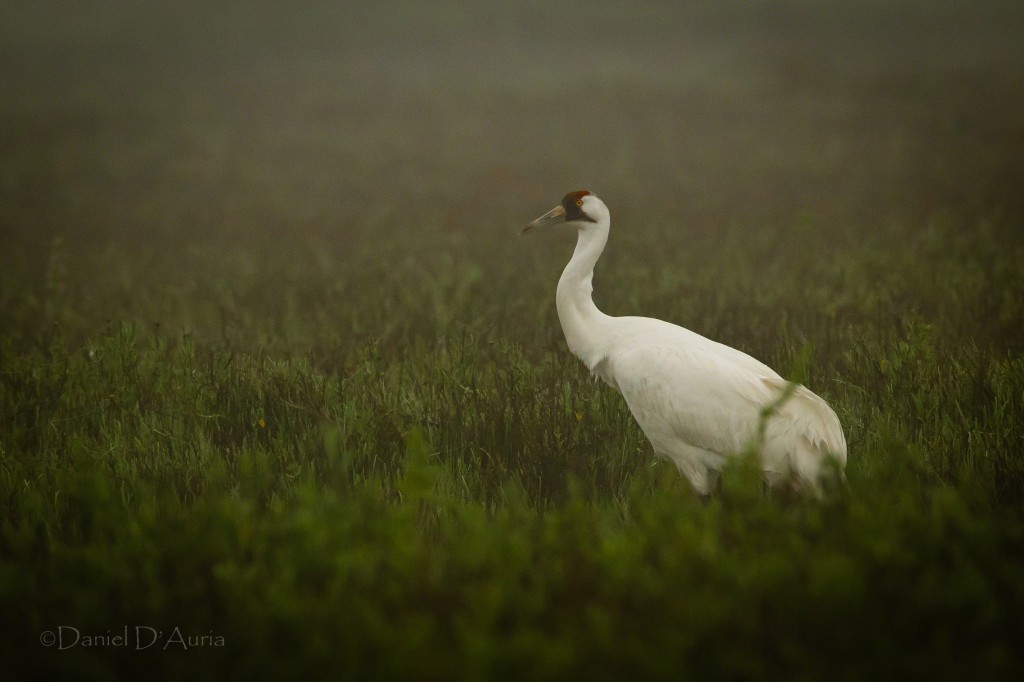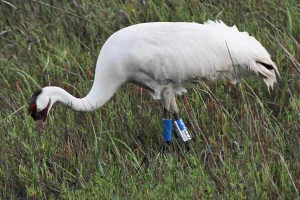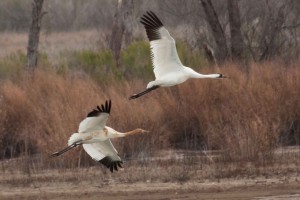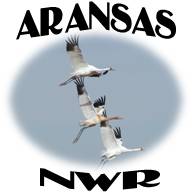Author Archive
Four Whooping Crane Flocks Thriving
April 21, 2012By: Chester McConnell, Whooping Crane Conservation Association
Western Whooping Crane Flock
“Only 5 whooping cranes remain on Aransas National Wildlife Refuge as of April 21” according to Dan Alonso, Refuge Manager. All others have begun their migration towards their nesting grounds at Wood Buffalo National Park, Canada. “Only 3 of the 29 whooping cranes carrying GPS transmitters remained on the refuge this past week” said Brad Strobel, Aransas Refuge biologist. Further north on the whooper migration route, Martha Tacha, U.S. Fish and Wildlife Service, reports that, “most of the cranes with GPS transmitters have now passed southern Nebraska and are continuing on their migration north. The cranes are currently distributed from northern Texas to northwestern Saskatchewan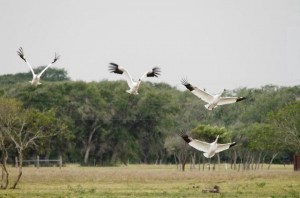 with some being within three days flying time of their Canadian nesting grounds. Some of the migrating whoopers were probably slowed last weekend due to the extensive strong storms from Oklahoma through South Dakota.”
with some being within three days flying time of their Canadian nesting grounds. Some of the migrating whoopers were probably slowed last weekend due to the extensive strong storms from Oklahoma through South Dakota.”
Further north on the migration route, wildlife technician Lea Craig-Moore, Canadian Wildlife Services reports that, “Whooping crane migration is in full swing in the Saskatchewan area.” She advised, “We have had the first flush of arrivals in the province and have birds spread from the SE prairie to the NW boreal. Family groups have been seen in a number of locations. Young cranes are learning the preferred stopover sites from their parents as they migrate.”
Eastern Whooping Crane Flock
Most of the whooping cranes in the eastern experimental flock have now reached their Wisconsin nesting area. Wisconsin Department of Natural Resources pilot Bev Paulan conducted an aerial survey April 17th and reported that there are currently 10 active nests located in the core reintroduction area in Wisconsin. Three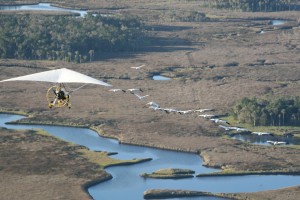 nests were abandoned earlier. Ten more pairs could possibly nest. Heather Ray, Operation Migration advises that “Hopes are high for baby chicks!”
nests were abandoned earlier. Ten more pairs could possibly nest. Heather Ray, Operation Migration advises that “Hopes are high for baby chicks!”
For several weeks, there has been much interest on the 9 young whooping cranes led south by Operation Migration ultralight planes to Alabama. Due, in part to government regulations, the young birds were finally placed on Wheeler National Wildlife Refuge in Alabama to spend the winter. On April 12 the 9 departed Alabama together on their first unaided journey north. They split into two or more groups during migration, and may be back in Wisconsin as you read this. Not quite a year old, the cranes are too young to pair up or breed. They will wander around the Wisconsin area nesting area and learn how to be whooping cranes.
Louisiana Non-Migratory Flock of Whooping Cranes
On December 1, 2011, a second cohort of juvenile whooping cranes was shipped to Louisiana from the Patuxent Wildlife Research Center. As with the first cohort, the 16 new birds (7 males, 9 females) were initially held in the top‐netted pen. Permanent bands and transmitters were attached to their legs on 8‐9 December and the birds were released into the open pen on 27 December.
On 31 December L4‐10, a survivor from the first cohort, returned to the pen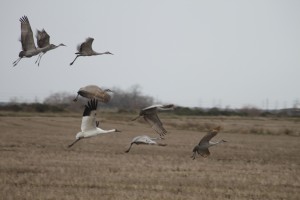 site and joined the 16 chicks. He had spent almost all summer and fall in the marsh just west of the release area and therefore had the strongest ties to the area. The 16 juveniles initially attempted to chase him away and while they continue to keep him away from the food shelter and the feeders they generally became more tolerant of his presence. Food continued to be provided for the birds in the open pen but will soon be discontinued.
site and joined the 16 chicks. He had spent almost all summer and fall in the marsh just west of the release area and therefore had the strongest ties to the area. The 16 juveniles initially attempted to chase him away and while they continue to keep him away from the food shelter and the feeders they generally became more tolerant of his presence. Food continued to be provided for the birds in the open pen but will soon be discontinued.
The young whoopers have shown a similar pattern of movement and pen use to the previous cohort – roosting outside the pen at night but using the pen during the day, primarily in the afternoons. However, with more water across the marsh this group of birds is beginning to range further away from the pen and use areas on the east side of the property which the first cohort did not use.
Florida Non-migratory Flock of Whooping Cranes
Marty Folk, Florida Fish and Wildlife Conservation Commission reports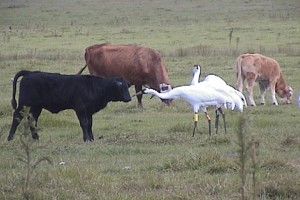 that, “As of 1 February 2012 we estimated there were 19 whooping cranes in the Florida resident population (8 males, 11 females) including 7 pairs. Again, this year, we will study the nesting ecology of these whooping cranes and Florida sandhill cranes. The goals are to determine causes of nest failure, compare the incubation behavior of the 2 species, and determine the efficacy of several research tools for these purposes. The nesting season has begun with our first sandhill crane nest just discovered in Polk County. Drought continues to plague Florida’s wetlands. The northern range of these cranes is very dry and unlikely to support much crane nesting. Fortunately, further south, we have some water for nesting.”
that, “As of 1 February 2012 we estimated there were 19 whooping cranes in the Florida resident population (8 males, 11 females) including 7 pairs. Again, this year, we will study the nesting ecology of these whooping cranes and Florida sandhill cranes. The goals are to determine causes of nest failure, compare the incubation behavior of the 2 species, and determine the efficacy of several research tools for these purposes. The nesting season has begun with our first sandhill crane nest just discovered in Polk County. Drought continues to plague Florida’s wetlands. The northern range of these cranes is very dry and unlikely to support much crane nesting. Fortunately, further south, we have some water for nesting.”
Whooping Crane Update –April 12, 2012
April 12, 2012Aransas National Wildlife Refuge has completed its update report on the status of whooping cranes on the refuge, migration progress, current habitat conditions, and status on birds found dead. To read the full report click on the following link:
Aransas National Wildlife Refuge Update Report (041212_WCUpdate)
Whooping Cranes Begin Migration to Canada
April 12, 2012An estimated 115 whooping cranes remain on, or near the Aransas National Wildlife Refuge in Texas according the U.S. Fish and Wildlife Service. Aransas Refuge officials report that, “Data from GPS-marked whooping cranes also indicates many of the birds have begun their migration. Approximately two thirds of the marked birds have left the Texas coast. Departure dates for those cranes in migration range between the 5th of March and 10th of April with 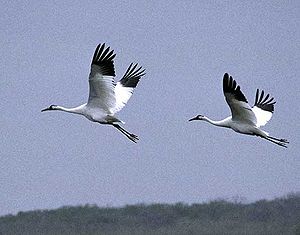 an average departure date of 29 March. To date, none of the marked birds have arrived at Wood-Buffalo National Park. We continue to download data from the radio-marked birds, as well as receive information from actual sightings.”
an average departure date of 29 March. To date, none of the marked birds have arrived at Wood-Buffalo National Park. We continue to download data from the radio-marked birds, as well as receive information from actual sightings.”
Reports of whooping crane sightings made to the Whooping Crane Conservation Association indicate migrating birds are in every U.S. state and Canada along the migration route. The migration appears to be earlier this year and may be due to the warmer weather. Hopefully the nesting grounds at Wood Buffalo National Park, Canada will be in suitable condition when the whoopers arrive there. here.
For those whoopers currently remaining on Aransas Refuge, habitat conditions appear to be improving. Aransas personnel report that, “As of April 11, the monthly precipitation totals for Aransas National Wildlife Refuge are 1.19 inches. Salinity levels in San Antonio Bay continue to remain under 20 parts per thousand (ppt) and are currently recorded at 16.5 ppt. Increased precipitation and fresh water inflows from Central Texas are helping to improve conditions in the marsh but the refuge is still not to pre-drought conditions.”
Remote Tracking of Aransas-Wood Buffalo Whooping Cranes
April 10, 2012By: Aaron Pearse, USGS Northern Prairie Wildlife Research Center and Brad Strobel, USFWS, Aransas Wildlife Refuge
Since 2009, a partnership of agencies and organizations has been conducting research on the Aransas‐Wood Buffalo population of Whooping Cranes. Fundamental objectives of our research efforts are: 1) to advance knowledge of Whooping Crane breeding, wintering, and migratory ecology, including threats to survival and population persistence; 2) to disseminate research findings in reports, presentations, and peer‐reviewed literature to provide reliable scientific knowledge for conservation, management, and recovery of Whooping Cranes; and 3) to minimize negative effects of research activities to Whooping Cranes.
Funds and personnel in support of this endeavor are being contributed by the Canadian Wildlife Service, The Crane Trust, Plate River Recovery Implementation Program, U.S. Fish and Wildlife Service, U.S. Geological Survey, Parks Canada, International Crane Foundation, and Gulf Coast Bird Observatory.
To meet objectives, members of the partnership have captured and marked 35 Whooping Cranes. We captured one juvenile and two adults along the Gulf Coast of Texas during winters 2009 and 2010. Capture teams marked nine juveniles during August 2010 and 12 juveniles during August 2011 at Wood Buffalo National Park in Canada. In December 2011, we successfully captured and marked 11 cranes on Aransas National Wildlife Refuge, eight of which were known or suspected paired adults.
Capture teams consist of individuals with experience handling and marking endangered cranes. At capture, a licensed veterinarian performs a health check on each crane, which includes an external examination and screenings for pathogens, toxins, and parasites. We affix all captured cranes with a satellite transmitter (Platform Transmitting Terminal) with Global Positioning System capabilities mounted on a two‐piece leg band. The transmitter and leg band weigh approximately 72 g, which is <1.5% of body weight of adult cranes.
Integrated solar panels on all exposed surfaces allow transmitters to function for approximately three to five years. Transmitters record GPS locations every six hours, providing detailed information on nocturnal and diurnal site use and general flight paths.
Approximately every 56 hours, transmitters upload new data, which assists in identifying mortality events when possible.
We have been collecting location data on marked birds since December 2009 and expect data collection to continue for at least the next three years. As our sample of marked cranes has expanded in 2011, expectation among research partners has increased as we begin to explore the volume of rich information provided by marked individuals. Partners agree that this opportunity to mark wild Whooping Cranes with GPS technology represents an exceptional prospect to enhance our understanding of whooping Cranes and assess risks they face during their entire life cycle.
Article from The Unison Call, newsletter of the North American Crane Working Group
Non-Migratory Whooping Cranes -Louisiana Update
April 7, 2012Louisiana Whooping Cranes – February 2012
By: Sara Zimorski, Louisiana Department of Wildlife and Fisheries.
2010 Cohort
After dispersing away from the release pen most of the birds from this group of 10 left the marsh and moved north into agricultural areas, primarily rice and crawfish. As previously reported 1 bird became sick and was euthanized, 1 bird was likely killed by a predator, and a third bird disappeared and is presumed dead.
Summer research of the remaining 7 focused on evaluating the habitat chosen by the birds. In early October, 2 birds in a group of 3 were shot and killed by a pair of teenage boys. An eyewitness reported the shooting and state law enforcement agents were able to apprehend the suspects and move forward with pressing charges. The case will be going to court in the very near future. The third bird’s transmitter failed and she disappeared at the same time the others were shot. With no additional data or sightings she is missing and presumed dead and foul play is suspected to be a factor in her disappearance. As a result of the shooting incident the Louisiana Department of Wildlife and Fisheries has stepped up our outreach and education efforts, including working to develop Whooping Crane‐related lesson plans and curriculums that will be incorporated into public school classes for middle and high school students.
Unfortunately in late November an additional bird was killed, likely by a predator, reducing the 2010 cohort to only 3 survivors. The 3 survivors remain separate from each other with 2 remaining in agricultural areas and the third returning to the pen and joining the new group of chicks.
2011 Cohort
On 1 December 2011, a second cohort of birds was shipped to Louisiana from the Patuxent Wildlife Research Center. As with the first cohort, the 16 new birds (7 males, 9 females) were initially held in the top‐netted pen. Permanent bands and transmitters were attached to their legs on 8‐9 December and the birds were released into the open pen on 27 December.
On 31 December L4‐10, a survivor from the first cohort, returned to the pen site and joined the 16 chicks. He had spent almost all summer and fall in the marsh just west of the release area and therefore had the strongest ties to the area. The 16 juveniles initially attempted to chase him away and while they continue to keep him away from the food shelter and the feeders they have generally become more tolerant of his presence. Food continues to be provided for the birds in the open pen but will be discontinued in the next few weeks.
The birds have shown a similar pattern of movement and pen use to the previous cohort – roosting outside the pen at night but using the pen during the day, primarily in the afternoons. However, with more water across the marsh this group of birds is beginning to range further away from the pen and use areas on the east side of the property which the first cohort did not use.
On 4 January, chick L14‐11 was handled to replace the original transmitter she had been given which was not functioning properly and during this time she apparently suffered an injury that left her unable to fly. On 19 January she was brought to the LSU vet school for evaluation and radiographs revealed a fractured leg coracoid bone. In order to give her the best chance of recovering the ability to fly and be released in Louisiana, surgery was performed on 27 January.
Surgeons at the vet school realigned the ends of the fractured bone and attached a small metal plate to stabilize the site. Her recovery is going well thus far and we are hopeful she will soon be able to fly again so she can live in the wild in LA with the rest of the cohort.
Unfortunately one chick, L12‐11, disappeared on 3 February. With no data from his transmitter and no sightings since then he is believed to be dead. As of 17 February, 18 (8 males, 10 females) birds remain alive in LA.
Article from The Unison Call, newsletter of the North American Crane Working Group
“Lobstick” Worlds Oldest Whooping Crane
March 30, 2012Tom Stehn, retired Chair of the International Whooping Crane Recovery Team has authored a captioned slide show about “Lobstick” the whooping crane. Lobstick is believed to be the oldest whooping crane in the world. He will be 34 years old this June. Lobstick, a male, is a member of the Aransas-Wood Buffalo whooping crane population. He has often been in the news concerning his role as a whooper parent and during his migratory flights from his Canada nesting habitat to the Texas wintering area.
To view the slide show, please visit “Journey North’s” outstanding educational web site. Click this link to see photos and read Lobstick’s astonishing story.
Aransas National Wildlife Refuge Update
March 29, 2012Aransas National Wildlife Refuge, U.S. Fish and Wildlife Service issued a report today describing the status of the whooping crane population on the refuge, water conditions and habitat improvements. Some whooping cranes have already started their migration north towards their nesting area at Buffalo National Park, Canada. Click on the following ling for the full report:
Whooping Crane Update – Aransas Refuge
March 29, 2012Whooping Crane Update –Aransas Refuge, U.S. Fish and Wildlife Service, March 29, 2012
Precipitation/Salinity: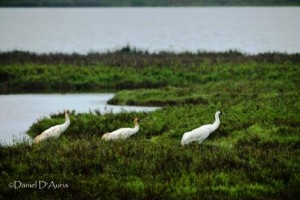
As of March 28, the monthly precipitation totals for Aransas National Wildlife Refuge are 2.41 inches and salinity levels in San Antonio Bay are recorded as 19.7 parts per thousand. With salinity levels below 20 parts per thousand, conditions in the marsh continue to normalize and food production for the birds improves. Even so, the refuge is still not to pre-drought conditions and biologists remain concerned. Photo by Daniel D’Auria
Food Sources:
Since the last update, the refuge has completed all of the prescribed burns for the season. The changing weather makes it difficult to safely and effectively conduct any more. The refuge was able to burn a total of 12,310 acres of habitat, areas targeted because of their value to whooping crane food source.
Reports:
The refuge is still waiting on the final report from the second carcass (recovered January 18). The third carcass (recovered February 29, 2012) was examined by the National Wildlife Health Center in Madison, WI. Results from this necropsy were inconclusive due to the extensive scavenging that had occurred to the carcass. However, bone marrow was found to contain
several bacteria strains.
The refuge will issue a final ‘State of the Cranes’ report summarizing the significant events that occurred during the 2011-12 whooping crane season.
Surveys:
Biologists hope to get in one last flight before the change in weather makes it too difficult. A flight is scheduled for today, Thursday March 29th. Analysis of data collected from previous surveys is still ongoing and will be presented in the annual report provided by the refuge.
Radio-marked birds and sightings of cranes from the flyway indicate the birds have begun their northern migration back to Wood Buffalo National Park in the Northwest Territories of Canada where they nest exclusively.
Supplemental Feeding:
The refuge continues to get questions regarding supplemental feeding. At this time, the refuge is concerned about the negative impacts of supplemental feeding. Previous efforts to supplemental feed were not considered successful as only a small portion of the birds actually fed on the shelled corn. Whooping cranes are territorial and do not naturally gather together to feed. Encouraging them to do so changes their natural behavior; it also creates greater opportunities to transmit diseases, parasites, and makes them more vulnerable to predators. Furthermore, when left out in warm and moist environments, like coastal marsh
areas, corn can grow Aspergillis molds. Aflatoxins, which are produced by the molds, can be lethal to whooping cranes and other wildlife. Where whooping cranes may be present, landowners should be aware of the risks that aflatoxins pose. If corn is being used for feeding other wildlife in areas where whooping cranes may be present, we highly recommend purchasing aflatoxin-free corn.
Aransas Whooping Crane Update – 196 birds
March 15, 2012by: Chester McConnell, Whooping Crane Conservation Association
It appears that we may never know if the Aransas – Wood Buffalo population of whooping cranes reached the hoped for 300 birds during 2011 – 2012. The weather has been a large factor. First, an unknown number of whoopers cranes did not arrive at Aransas National Wildlife Refuge. Then some traveled around in Texas counties near Aransas Refuge while others spent the winter in Kansas and Nebraska. And weather had a crippling effect on attempts to count the whoopers that did winter on Aransas Refuge.
According to Aransas personnel, “High winds and low cloud cover impeded the census flights scheduled during late February, allowing for only two of the three scheduled census flights. Those flights were conducted on February 25 and 26, 2012. Peliminary data analyses indicated the population of cranes within the surveyed area was 196. Although lower than the previous 245 estimate, the difference is not statistically significant and most likely the result of limited flying time. Also, this number does not reflect whooping cranes outside the survey area, including those that have dispersed.
Radio-marked birds and sightings of whooping cranes from the flyway indicate the birds have begun their northern migration back to Wood Buffalo National Park in the Northwest Territories of Canada where they nest exclusively. Some biologist believe that this earlier than usual northern migration is also due to the unseasonal warm weather. Depending on the weather, biologists hope to conduct another census flight before the end of the month.
Refuge officials also issued an update on the status of whooping cranes that died during the past several months. A report from the first whooper carcass (recovered Dec. 7, 2011) was issued from the National Wildlife Health Center (NWHC) and it indicates the bird had a systemic blood infection. This type of systemic infection has been known to cause death. The refuge is still waiting on the final report from the second carcass (recovered January 18, 2012). A third carcass of a radio-collared bird was recovered (Feb. 29, 2012) and sent to the NWHC in Madison, WI last week for necropsy.
Some good weather news relating to the whoopers is that, as of March 14, the monthly precipitation totals for Aransas National Wildlife Refuge are .85 inches and salinity levels in San Antonio Bay are recorded as 19.7 parts per thousand. With salinity levels below 20 parts per thousand, conditions in the marsh are normalizing and food production for the birds improving. Even so, the refuge is still not to pre-drought conditions and biologists remain concerned.
Since the last Aransas Refuge update, the refuge conducted an additional prescribed burn, raising the winter’s total to 12,310 acres of habitat. The refuge’s fire program hopes to conduct a final burn in the next few weeks on Matagorda Island but the changing weather makes it uncertain. Despite one burn remaining, all of the burns planned in areas whooping cranes would likely use have been completed and were successful.
Aransas NWR Update 3-1-2012
March 1, 2012Aransas National Wildlife Refuge, U.S. Fish and Wildlife Service posted its Update Report on 3-1-2012. A new aerial census was completed in February but an analysis of the numbers has not been completed. New whooping crane census numbers will be reported as soon as analysis is complete. Recent rain fall has helped lower the salinity levels in area bays where the whooping cranes feed. More prescribed fires have been completed making more food available to the cranes.
Click on link to read full report: 030112_WCUpdate 3-1-12
